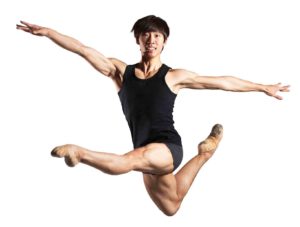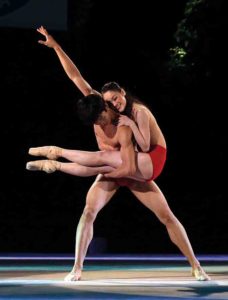A Promising Pair: The Royal Winnipeg Ballet’s new second soloists, Saeka Shirai and Yue Shi - Vancouver Ballet Society
- Home
- Features 2015 - 2019
- A Promising Pair: The Royal Winnipeg Ballet’s new second soloists, Saeka Shirai and Yue Shi

by Holly Harris
Japanese dancer Saeka Shirai and Chinese-born Yue Shi, frequent partners at the Royal Winnipeg Ballet, were recently promoted from the corps de ballet to second soloist positions. Shirai, 22, and Shi, 21, have been wowing audiences with their flawless technique and mature artistry, notably having been awarded a silver medal at the 27th Varna International Ballet Competition in 2016 for their program of classical and contemporary works.
Born in Osaka to a close-knit family of five, Shirai began training at age three, at the Yuki Ballet Studio. In 2009, she performed at the Youth America Grand Prix (YAGP) New York finals and, in 2011, at the Prix de Lausanne. There, the 16-year-old was offered a full scholarship to the Royal Winnipeg Ballet School Professional Division, graduating in 2014 at the top of her class.
Ballet competitions get mixed reviews, but Shirai says her experience has only been positive, crystallizing her aspirations for a stage career.
“I started doing competitions in Japan, and wanted more and more,” she says. “The YAGP was my first competition outside Japan, so that was both scary and exciting. But I could relate to everyone there because we were all dancers going through the same thing. Competitions have helped me develop my personality and made me stronger as a dancer.”
After joining the RWB Aspirant Program in 2015 — essentially becoming a company apprentice — she was promoted to the corps de ballet in 2016. Last season, she debuted as Princess Aurora in The Sleeping Beauty and danced in the Giselle Pas de Six, as well as taking on the role of Princess Irene in Twyla Tharp’s The Princess and the Goblin. Closest to her heart is the elfin Tinkerbell in Jorden Morris’ Peter Pan, with her sprightly portrayal lauded in Winnipeg’s French language newspaper La Liberté as the revelation of the evening.

“It was such a fun role,” Shirai says of her tempestuous character, who was often airborne in a harness, soaring high across the stage to evoke flying through air.
The petite artist, who stands just five-foot-two (157 centimetres), has carefully honed her technique to create the compelling onstage presence of a principal dancer. “Because I’m shorter and tinier than anyone, I have to dance bigger,” she reveals. “All my steps have to be one inch longer. I’m always thinking of how to do that, but it’s quite difficult, too, as the balance is different.”
Shi is a perfect partner for her. Born in Tangshan, Shi first studied ballet at the Liaoning Ballet School at age 10, and began to enter international ballet competitions in 2010, winning awards in Osaka, Beijing, Seoul and Moscow. He joined the RWB Aspirant Program in 2015 after catching the eye of jury member and RWB artistic director André Lewis at the 2014 Jackson International Ballet Competition, where he received a Special Jury Award. He joined the RWB corps de ballet in 2016. His roles now include the Prince in Nutcracker, Jester in Swan Lake and his favourite, Prince Desire from Sleeping Beauty, which he also guest performed with the Sofia National Opera Ballet.
His dreams of a ballet career first took flight after seeing Daniil Simkin dancing with American Ballet Theatre in a television broadcast of Don Quixote. “I saw him doing all his tricks and they looked so easy,” Shi recalls. “His jumps were so high and so even. It made me excited to do ballet, and my mom told me when he was dancing, I was dancing, too.”
Both artists, who learned English after arriving in Winnipeg by studying YouTube videos and taking crash language courses — English becoming their lingua franca when rehearsing together — possess a strong work ethic fueled by a laser focus. They both aspire to become principal dancers — Shi gives himself three years — while continuing to build their partnering skills.
Astonishingly, Shi only performed his first pas de deux in May 2016, when he teamed up with Shirai for Marius Petipa’s Don Quixote Pas de Deux during the RWB School Professional Division’s annual On the Edge production. He says he was inspired by Simkin’s performance of the classic. This was a mere three months before the duo won silver in Varna for their electrifying performance of the duet teeming with choreographic tricks: fouettés, pirouettes, piqué turns, double sauts de basque and switch splits.
RWB ballet master Jaime Vargas, who coached the dancers for eight weeks leading up to the competition and accompanied them to Bulgaria, recalls often finding Shirai and Shi still hard at work in the studio well past six p.m. after a nearly five-hour rehearsal day. They would be working on perfecting their three classical pas de deux (from La Fille mal gardée, Diana and Actaeon and Don Quixote) plus two contemporary works, by Winnipeg-based Yosuke Mino (also a company soloist) and Peter Quanz, who has created works for ballet companies around the world.
“Their physical ability and their connections with their bodies,” replies Vargas, when asked to describe the young artists’ particular strengths. “Everything just makes sense.” He also comments on their obvious passion for their art. “They have an incredible dedication to whatever they’re doing; that played a huge role during rehearsals as it sets the state of mind.”
Equally important, Shirai and Shi also possess “grit.” Upon arriving in the Baltic seaside city for the competition, they were told that their only onstage dress rehearsal would occur at two o’clock in the morning due to tight scheduling demands. Heavily jetlagged, Shirai became especially alarmed at how slippery the unfamiliar, open-air theatre stage was for performing on pointe, which not only threatened their chance at winning medals, but also potentially posed career-ending physical injury.
Vargas took her aside to quell her nerves, pointing at the flocks of seagulls gliding over the Black Sea, and telling her that she, too, could soar. The avian imagery did the trick — as did his invaluable technical advice to always be straight on top of her leg.
“Jaime helped a lot,” Shirai says. “He gave me courage and made me feel like it was possible — and that I had to trust myself. We had worked so hard and there was no turning back.” Any last-minute jitters quickly settled as soon as she took the stage with Shi. “When the music starts, it just carries you,” she says.
The pair was exhilarated to discover a large photograph mounted on the wall in one of the rehearsal studios showing prima ballerina assoluta Evelyn Hart and the late David Peregrine performing Norbert Vesak’s Belong in 1980, further emboldening them on their path. The RWB’s two former principal dancers received the gold medal at Varna that year for their searing interpretation of Belong, which put the company on the international map.
“I had watched Evelyn Hart on YouTube, and wanted to be just like her,’” Shirai says, who met Hart last year during the ballerina’s guest appearance in the RWB’s premiere of James Kudelka’s Vespers.
Shi (who earned a gold medal in Varna’s junior category in 2014) knows how important Varna has been to the RWB, and, when he saw that photo, he felt “so proud to be there and to represent Canada.”
In November 2017, when they performed Belong back home in Winnipeg in the RWB’s mixed bill, Our Story, Lewis, who had performed the pas de deux many times during his years as a company dancer, personally coached them. “They hit all of the great moments in perfect unison. Saeka and Yue added a spirit reminiscent of Evelyn Hart and David Peregrine’s iconic Belong performance in Varna,” he adds — the highest compliment of all.
For Shi, watching the other international competitors at Varna was inspiring. “When I saw those amazing dancers onstage, it gave me the feeling to push even more.”

Did he experience stage fright during the high stakes competition, live streamed around the world? “I didn’t feel pressure at all, because I’m a dancer,” Shi states matter-of-factly. “Dancers have to show they’re not afraid to do anything. I just feel excited when I’m onstage.”
Both artists are equally at home with classical and contemporary repertoire. Mino choreographed Numa especially for them for Varna to showcase their artistic versatility. It meant Shirai had to morph from innocent village girl Lise in La Fille mal gardée to a passionate woman for the Mino work. Quanz’s sparkling duet Blushing, set to an electric violin score, was created in 2014 for his company, Q Dance.
“Saeka and Yue come from very different perspectives,” says Quanz. “Saeka is a stylist and wants each movement to have the correct shape and historical value. Yue’s training focused on expanding physical limitations, which led to his extraordinary jumps, perfection of line and an unending ability to turn. It is in part because of these opposing approaches that they make a great partnership. Saeka contributes a liquid-like way of connecting movements, while Yue offers a thrilling variety of tone. It is clear that both love to dance. They seek to find the heart of the choreography and go deeper to find the spirit within the work.”
He also crafted several exquisite moments evoking the cherry blossoms Shirai adores from her home in Japan. “I tried to give Saeka many images of walking through a grove of flowering trees. That shaped her movement and gave it a sort of perfume: an elegance, a softness,” Quanz says.
“Working with Peter is fun, because he pushes us,” Shi states. “When I did a double tour, he’d say, ‘Can you do six?’ There are some hard tricks in Blushing. But we worked very hard every day in rehearsals and it now feels easy for us. Saeka is a really good partner. You have to trust each other and be very, very connected and feel each other’s body.”
As they continue to put their roots down into Prairie soil — both are currently on work permits, with Shi having applied for permanent residency — the two artists look forward to honing their artistry as individual dance artists and as partners.
Shi, who likes to draw, listen to music and works out daily at the gym to build muscle that will “protect his body and bones,” says of their partnership: “After being onstage together, it feels like, ‘OK, we did it.’ That is the most important feeling of all.”
Shirai, who plays piano, enjoys Sudoku and poring through YouTube videos of ballet dancers, says, “I want people to feel something, to share something with me when I dance. My goal is for people to see me onstage and say, ‘I want to see her dance again.’”

